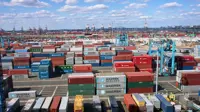China's April industrial output grows at 7.3 per cent, lower than March’s 8.3 per cent
13 May 2009
China's industrial output grew 7.3 per cent in April from a year earlier, the National Bureau of Statistics said on Wednesday. It was slower than the 8.3 per cent in March indicating slow down in exports still continue to hit the world's third-largest trade-dependent economy on account of global downturn.
The data was in line with analysts' expectation of between 7.1 per cent and 7.3 per cent.
Growth in industrial output, the main gauge of activity in factories and plants across China, was up 5.5 per cent year on year for January-April period.
Industrial output for exports was 566.21 billion yuan ($83.27 billion) last month, down 14.3 per cent from a year earlier, the National Bureau of Statistics said.
Exports declined 22.6 per cent in April for the sixth consecutive month while power consumption dropped 3.5 per cent year on year to 271.29 billion kilowatt-hours in April.(See: China's exports plunge, investment surges amid mixed cues)
The iron and steel industry's output decreased 1.7 per cent. The textile industry's output was up 7.8 per cent while transportation facility manufacturing rose 9.6 per cent.
Cement output increased 12.9 per cent from a year earlier indicating construction activities continued to be strong. Similarly automobiles, air-conditioners and oil products did well.
The quarterly economic prediction from the StateInformation Center (SIC), a government think-tank, had early this month said Industrial production hadn't resumed high growth in the second quarter, and China would strive to trim excess capacity after the process of destocking was completed. SIC had predicted industrial output would grow 7.1 per cent in the second quarter.
The report added that after five years of rapid expansion and runaway investment, industrial capacity grew rapidly and the world economy turned down before the new capacity added could be fully utilised by the market.
Closing excess capacity would be a long, arduous task, said the report.
China's investments in factories and property development, however, jumped 30.5 per cent from a year earlier in the first four months of the year. The growth stemmed from the government's stimulus projects under which it pumped $543.2 billion in the form of bank loans.
The January-April period saw China's banks issue about $757 billion in new loans this year, in response to government policies for financing of infrastructure projects to boost employment and stimulate demand.
But with a two-thirds drop in new lending in April as compared with March to $86.6 billion trends suggest that spending may wind down in coming months as the huge inflows are absorbed in the economy.
The broad measure of money supply increased 25.95 per cent to 54.05 trillion yuan at end of April from a year earlier, the central bank said Monday.
The data reveals the government's efforts are leading to increase in domestic growth but exports and export-depended industries are badly hit due to the global recession.
The World Bank has forecast that China's economy will grow by just 6.5 per cent in 2009, down from the 13 per cent in 2007 and 9 per cent in 2008. (See: Chinese revival may start this year: World Bank)
China's consumer price index (CPI), the main gauge of inflation, fell 1.5 per cent year on year in April, for the third consecutive month to almost late 2002 levels while the producer price index (PPI), a major measure of inflation at the wholesale level, fell 6.6 per cent in April year on year, for the fourth consecutive month. (See: China's April CPI down 1.5 per cent, PPI down 6.6 per cent, may avoid deflation)
The Chinese government is asking banks to lend more to boost growth and new loans are expected to surge more than 57 per cent in 2009. (See: China sees an 8 trillion yen loan surge in 2009)
The People's Bank of China said in its quarterly report said that China's economy is fairing "better than expected" in the first quarter of 2009, and central bank would provide "ample" liquidity in the financial system to sustain economic recovery. (See: China central bank assures "ample" liquidity to sustain economic recovery)





.webp)


















